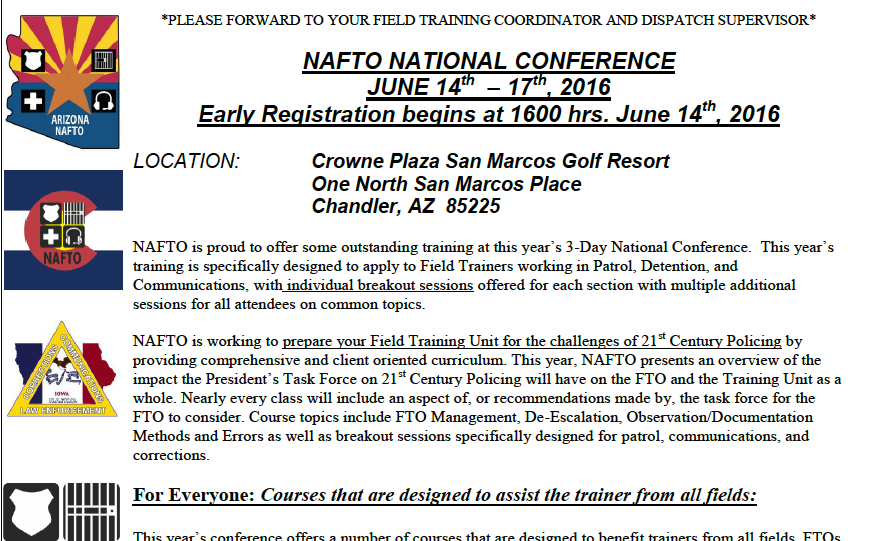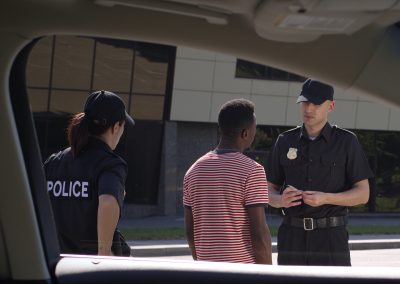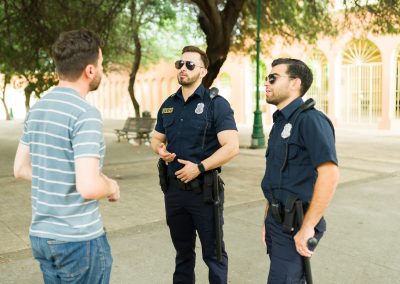Welcome to the second installment of our series on the President’s Task Force on 21st Century Policing and its impact on the field training unit. One aspect of NAFTO training, philosophy and mindset that I have always been very proud of is the fact that we are not chained to history. We believe that we can take our training and experience and move forward with time as law enforcement practices evolve.
They say that cops hate two things. Change … and the way things are. Funny and true for most of us. We hope to ease some nerves and help clear some muddy waters for training officers out there facing the winds of change as FTOs.
Recommendations
The second recommendation from the Task Force reads:
5.13.1 Action Item: The U.S. Department of Justice should support the development of broad Field Training Program standards and training strategies that address changing police culture and organizational procedural justice issues that agencies can adopt and customize to local needs.
A potential model for this is the Police Training Officer program developed by the COPS Office in collaboration with PERF and the Reno (Nevada) Police Department. This problem-based learning strategy used adult learning theory and problem solving tools to encourage new officers to think with a proactive mindset, enabling the identification of and solution to problems within their communities.
Obviously, the San Jose Model of training takes a big hit in the task Force’s report. Organizations such as PERF, COPS, and the Reno Police Department clearly support a PTO training program, (also known as the Reno Model). Many other agencies around the country use the PTO Model as well.
The PTO model and all of its moving pieces is extensive and complex. It’s a training concept far beyond the limits of a single article. However, every FTO should look it over and be familiar with it. There are several good ideas and concepts found in the model. You can find the PTO training manuals on the COPS website.
As was mentioned in Part 1 of this series, NAFTO is a model-neutral association. The system and mechanisms in place are important. Your training system should be rooted in a legally defensible, tested and tried training model. That being said, what may be more crucial to training than the system in place is the people you employ to work within it. You can have the most highly sought-after and recognized architect design your house. But if you don’t have dependable people in place for cleaning and maintenance then your home will deteriorate quickly.
What Does It Mean?
So let’s focus on the intangibles of recommendation 5.13.1. We see that the task force recommends a program with broad standards and training strategies that address changing police culture. What is changing within the police culture that needs to be addressed in the FTO program? Why does the PTO program seem to satisfy those changing needs?
After you research the PTO program you will find that the program is based on two fundamental principles. First, the culture the program is designed to enhance is a policing culture that puts community first. Second, the training strategy is centered on an idea called Problem-Based Learning (PBL). When you have some free time check out the website for the Center for Problem-Oriented Policing. This organization had a significant impact on developing the PTO program.
Both those principals sound good to all of us as trainers. But why do we need to adopt an entirely new training model to make them work for our agency. Well, my reply to that is … you don’t. If you feel that the PTO program as a whole is best for you then run with it. If not, take a look at what drives it and work it into your existing model.
Socialization is a key concept to NAFTO training. We talk about how important the culture of your FTO program is to your agency and to the young officers we train. Ethics, morals, values, work ethic and attitude are all wrapped up in culture. Culture is behavior and behavior is learned. It’s important your FTO program models positive behavior. If the idea of community has been forgotten within your training program, then you will no doubt train the same lack of community service to the next generation of officers.
Speaking of a changing police culture and the next generation, we have also realized the importance of training FTOs on how to better influence and motivate people of different generations. Influence and motivation is all about communication. Communication is all about knowing your audience. My message needs to be attractive to the receiver—not to me. So the more we know about what makes the Gen X lateral tick, the better. And if we know what interests the Gen Y new guy, the better my communication will be. The better my communication, the more influence I have over them. The more influence I have, the more of my training they retain.
In Sum
The aforementioned change to police culture is, we believe, less of a change and more of a reminder of what Sir Robert Peele wrote over 100 years ago. As part of his nine principles of policing, Peele wrote, “The police are the public and the public are the police …” There is an expectation that our FTO programs will need to be sure to include any and all community oriented topics in training as possible. What do those look like?
Here are just a few:
- Leadership;
- Problem-solving (specifically problems that are community-based);
- Cultural diversity;
- Special needs groups; and
- Legal authority/individual rights
How do those topics apply to your agency? How do your FTOs model those topics? How will you as an FTO train those topics? Have you provided your FTO with enough training in those topics to consider them experts in the field?
We pride ourselves on being at the forefront of training. The President’s Task Force has identified these concepts as critical to the future of police training. We want to help the FTO bring all of their training and experience with them as they evolve with police training culture. In our next installment we’ll attack the second part of the recommendation about training strategies.











0 Comments